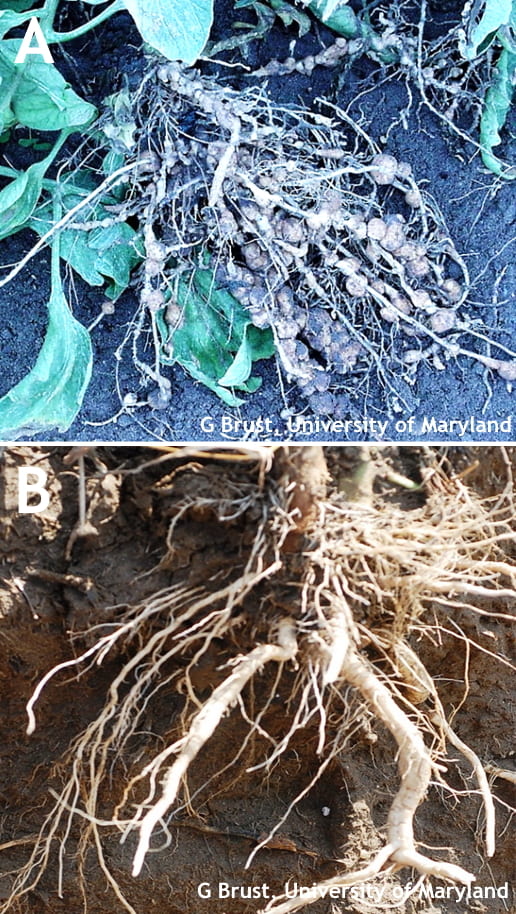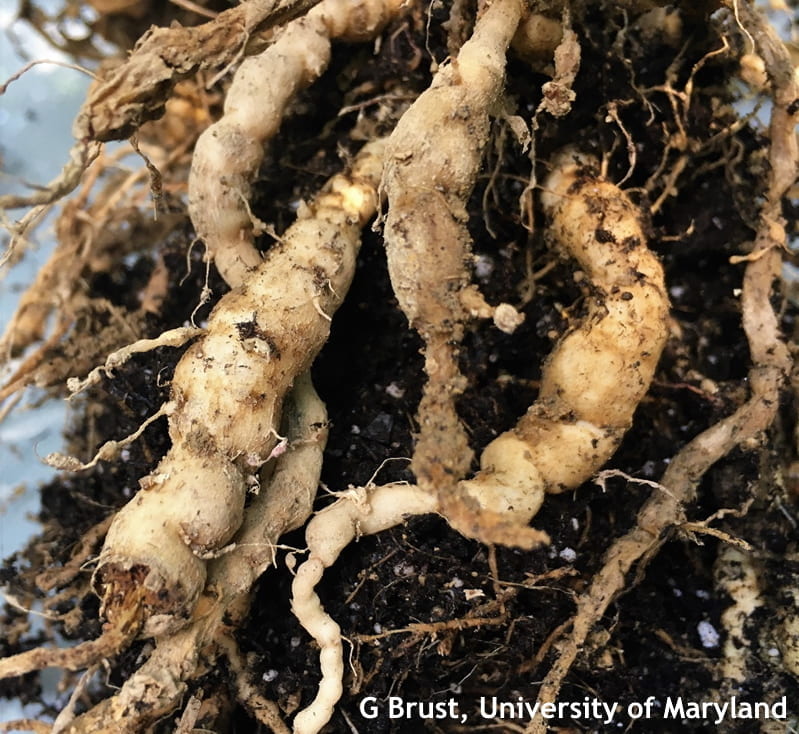Jerry Brust, IPM Vegetable Specialist, University of Maryland; jbrust@umd.edu
Each year I put this information out near the end of a growing season in the hopes that growers will take a look in their fields for root knot nematode problems as we are seeing increasing difficulties with this nematode complex over the last 4-5 years. So as this growing season winds down it is a good time to examine vegetable roots for root knot nematode (RKN) which can be done by growers with little equipment or time needed.
Where should a grower look in a field for this pest? I would be suspicious of having RKN if my vegetables seemed to need more water than normal or wilted during the heat of the day and recovered later or plants had nutrient deficiency symptoms and the addition of fertilizers did not seem to alleviate the deficiency symptoms. Other symptoms to be suspicious of include some plants appearing stunted with either lower yields or poorer fruit quality. If these vegetable problems were noticed in spots that seemed to follow down a row, there is a chance you have RKN and you should check your vegetable roots for galls.
When you are done harvesting your tomato, watermelon, cucumber, pepper field dig—do not pull up– your plants that are showing problems and some of the plants that border these problematic plants. If the ground is moist when you dig it makes the whole process much easier. Wash the roots with water or dip plant roots into a barrel of water and gently swish the roots around. Inspect the roots of the plants for the tell-tale symptoms of RKN, i.e., galls on the fine and larger roots of a plant (Fig. 1a) vs uninfected roots being white, smooth and thin (Fig. 1b). At other times entire roots can become swollen and appear ‘lumpy’ and rotted (Fig. 2).
Soil fumigants or nematicides can be effective in reducing RKN damage to vegetable roots, but they will not eliminate the pest from the soil and populations will still be high at the end of the season, but roots will be protected long enough for a crop to be produced. More information on fumigants and nematicides can be found in the 2022-2023 Mid-Atlantic Commercial Vegetable Production Recommendations guide.
There are other options that can be used to reduce RKN populations. One of these options is using certain cover crops that can decrease RKN severity and crop damage. Rapeseed (relative of canola) is one of these cover crops that is planted in late September early October in Maryland at 800,000-900,000 seeds per acre and letting it grow throughout the fall, winter and early spring and then tilling it under in mid-March through mid-April. Rapeseed crops have a high sulfur requirement, so be sure you have adequate levels of sulfur in your soils for this cover crop. The key is getting a good solid stand of the cover crop so that weeds do not grow along with the crop as many weed species can act as hosts for RKN.
In the summer a good cover crop to use is sorghum-sudangrass that can be planted following an early season vegetable crop such as cucumber, pea or snap bean. Planting seed at 20 lbs/a in mid to late July produces enough biomass to reduce RKN populations. For best control, the sorghum-sudangrass crop should be chopped while green into smaller pieces and incorporated into the soil by mid-October. Well incorporated sorghum-sudangrass can be as effective as fumigation. Adding poultry litter or poultry litter compost into the sorghum-sudangrass biomass produces the most effective reduction in nematodes.

Figure 1. Tomato roots with (a) and without galls (b) from root knot nematode infection

Figure 2. Lumpy rotted roots of a cucumber plant caused by RKN infection
